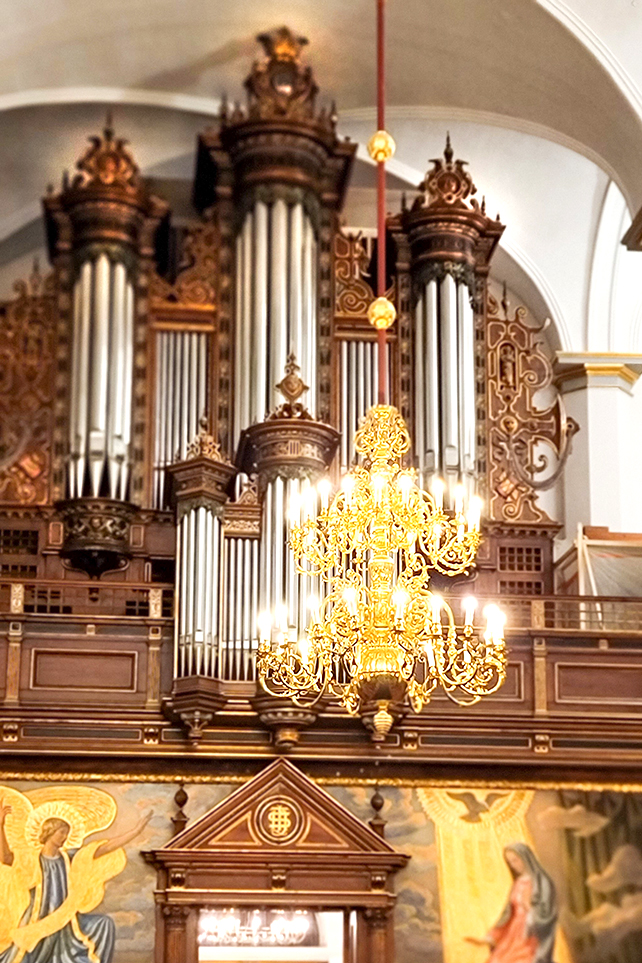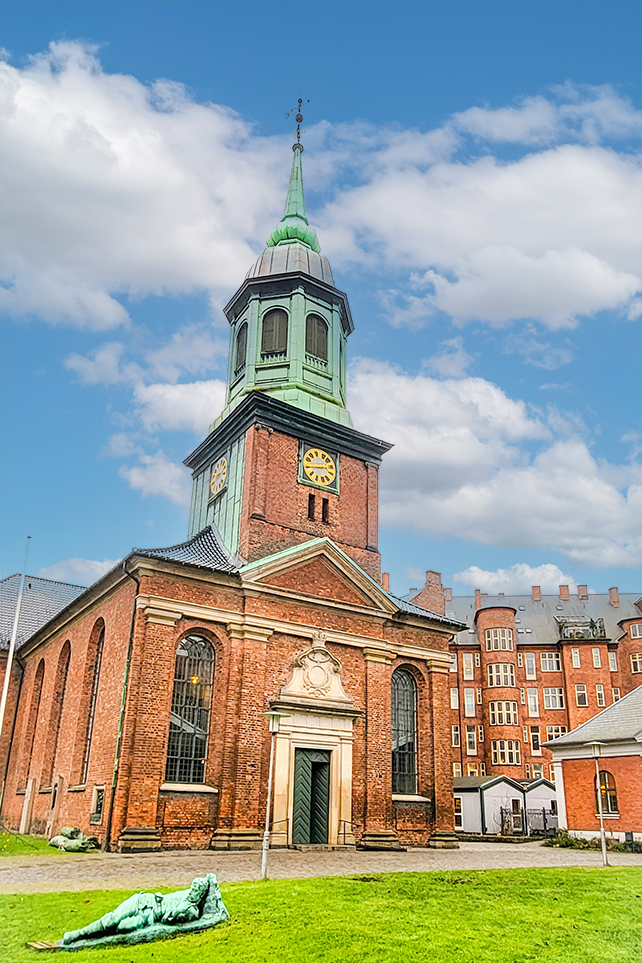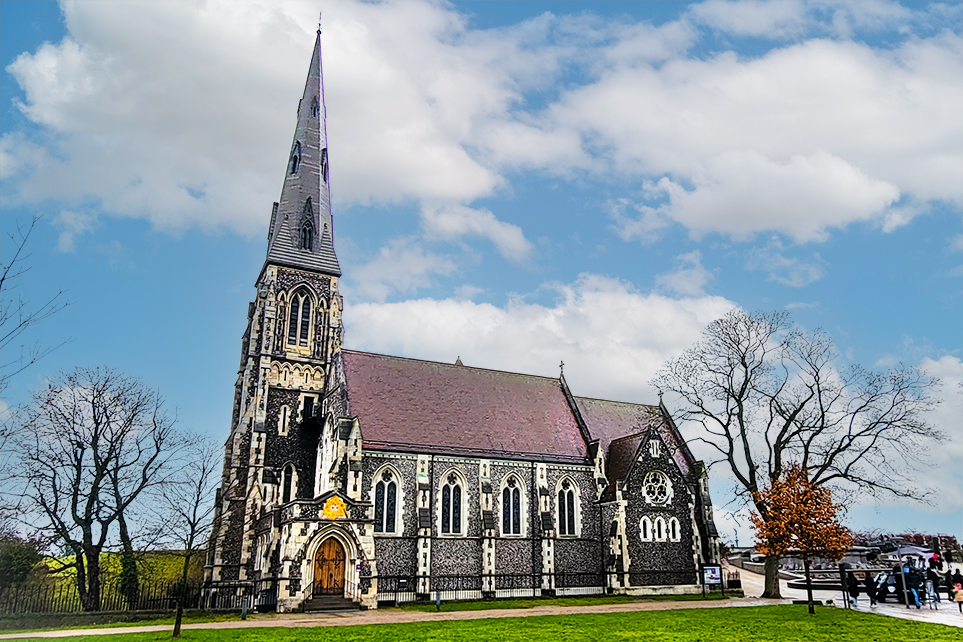
As my husband and I travel the world, we tend to spend time checking out local churches as this is where you can see many facets of historical events that have occurred over time. Even if you aren’t religious, visiting a church on your travels can be a good glimpse into the community and its beliefs. They each have their unique spin on what is believed to be the perfect universe.
Churches in Copenhagen are quite impressive. Each has its unique style and incredible architecture. Here, you can visit the spiral staircase to heaven on top of the Church of Our Saviour or admire the astonishing woodwork in the Holmen’s Church, where Denmark’s Queen Margaret II was married. Each Church, designed at different periods, was created to outshine the other.
Religion in Denmark
Christianity came to Denmark more than 1000 years ago as a part of the Viking king Harold Bluetooth. In 1536, the Danish Church became Lutheran and was integrated into the state. The Danish monarch is also the official head of the state church.
The Danish constitution guarantees freedom of religion and non-Christian religions in Denmark. Islam is the largest non-Christian religion in Denmark today. For more than 400 years, Jews have practiced their religion in Denmark. Although 75 percent of Danes identify themselves with the Evangelical Lutheran Church, only a fifth consider themselves “religious.” No matter your faith, it is accepted in Denmark.
Meaning Behind Model Ships Hanging from the Ceiling
As we visited many of the churches throughout Copenhagen, we noticed these beautifully crafted model ships hanging from the ceiling. These ships are hung to honor the city’s maritime tradition and history. Some are gifts from sailors who donated them to express their gratitude for a safe voyage. So, as you tour some of these beautiful churches, look out for these model ships.
Best Churches in Copenhagen
The Marble Church (Frederik’s Church)
Frederik’s Church is one of the most beautiful classical Roman baroque-style churches made from Norwegian and Danish marble and limestone. The design was inspired by St. Peter’s Basilica and is why you will see a massive copper dome, considered to be one of the largest in the world.
Around the outer top of the Church are impressive statues representing figures from religious history, while those closer to the ground level are notable people from the Danish Church.
- Hours: Monday – Thursday and Saturday: 10:00 – 17:00, Friday: 12:00 – 17:00, Sunday: 12:30 – 17:00
- Admission to Visit the Dome: Only Saturday and Sunday at 13:00; 35 DKK per person, cash only.

The Church of Our Saviour (Vor Frelsers Kirke)
Our Saviour’s Church was built in the 1680s and consecrated in 1696. Due to the expansion of the canals southward on the island of Amager, King Christian IV wanted to build a church to support the community.
Tourists are attracted to the interesting spire on top of the Church. It was designed by Lauritz de Thurah and inspired by the shape of Rome’s Sant’Ivo alla Sapienza. The copper-colored wooden spire stands on an octagonal base and features semicircular arches and round windows. 150 steps twist counterclockwise, looping around the four times. For a fee, you can climb the spire for a panoramic view of Copenhagen.
- Hours: Church: 11:00 – 15:30, free to enter; Tower: 9:00 – 20:00
- Admission: To Climb the Tower, 69 DKK per adult

Alexander Nevsky Church (Skt. Aleksander Nevskij Kirke)
The Russian Orthodox Church of Alexander Nevsky was donated by the Danish Princess Dagmar, who married Czar Alexander III of Russia. The Russian Government built the only Russian Orthodox Church in Copenhagen between 1881 and 1883.
The six synchronized bells chime throughout the day and can be heard throughout Copenhagen. Under the domes facing the street is a niche with an icon of St. Alexander Nevsky painted on a piece of lava rock. The Byzantine-style frescoes decorate the walls and ceiling, and the floors are designed in marble mosaics.
- Hours: Wednesday and Friday: 12:00 – 14:00

Trinity Church (Trinitatis Kirke)
Attached to the Round Tower is the Lutheran Trinity Church, which was commissioned in 1637 and consecrated in 1656 for the University of Copenhagen. The Church was built under the ruling Christian IV. The Church is composed of a mix of styles. Romanesque elements exist in the Round Tower’s frieze at the top of the tower and Gothic features in the pointed church windows.
The Church often offers free concerts throughout the year. Look at the Trinity Church calendar for more details.
- Hours: Mon. – Sat. 9:30 – 16:30; Sun. only during the services 9:30 – 12:00


Church of the Holy Spirit (Helligaandskirken)
Nestled in the middle of Strøget is the Church of The Holy Spirit. Originally built as a Catholic monastery but was consecrated as a Protestant Church in 1537.
The main church building was destroyed in one of the great fires of Copenhagen in 1729, but the portion you see today survived and is one of the oldest remaining medieval buildings in Copenhagen.
During our visit, we had the pleasure of attending a free Christmas concert. Check out their calendar of events, and make sure to make this a part of your plans.
- Hours: Mon.-Fri. 12:00 – 16:00, Sat. 11:00 – 13:00, Sun. during the summer, 10:00 (wintertime 11:00) is only open during Sunday church service.


Grundtvig’s Church
The Grundtvig’s Church is considered one of the most impressive architectural masterpieces in the world. Built-in the late 19th century in memory of N.F.S. Grundtvig, a Danish philosopher, author, and pastor, Grundtvig’s Church design was inspired by the Gothic Revival style.
The exterior features ornate spire towers with detailed stonework and large copper down. The interior is filled with breathtaking painted-glass windows and soaring ceilings.
One of the most impressive things to see is the pipe organ which can be found in the Church’s main hall. Built in 1890, it is one of the largest pipe organs in the world, with over 10,000 pipes made up of four levels, each with its unique sounds.
To reach Grundtvig’s Church, you must ride the 6A bus towards Buddinge Station from Nørreport Station. This will take about 15 minutes. You should get off the bus at Bispebierg Torv (Tagensvei), then walk five minutes to the Church.
- Hours: Tue. Wed, Fri., Sat. 9:00 – 16:00; Thur. 9:00 – 18:00; Sun. in the summer 12:00 – 16:00 (wintertime 12:00 – 13:00). Closed on Monday all year around
- Admission: Free guided tours are offered. Reserve your spot here.

Holmen’s Church
Built as a navy church by King Christian IV in 1619, situated on the side of Holmen’s Canal, the Holmen’s Church hosted royal weddings and baptisms over the years.
Queen Margrethe II and Prince Henrick of Denmark were married at Homens Church on Jen 10, 1967. The Crown Prince Fredrik was baptized in Holmen’s Church in 1968.
The Intricately carved oak altarpiece from 1661 and the pulpit crafted in 1662 is quite amazing detailed work. It is one of the oldest of Renaissance architecture in Copenhagen.
One artwork I found so interesting was the votive ship hanging from the ceiling, a model of the Christianus Quintus Niel Juel’s warship from 1674.
You can also find some of the most prominent Danish naval heroes sarcophaguses within the chapel, such as Niel Juel and Peter Wessel Tordenskiold.
- Hours: 10:00 – 16:00

The Garrison Church
Initially built in 1706, the Garrison Church was erected to serve the military personnel stationed in the city primarily. Located close to the Amalienborg is an architectural marvel standing tall in Sankt Anna Place. The beautiful façade with iron windows is designed in authentic Roman architecture.
From the outside, the Church doesn’t seem like much, but once inside, the two-floor level Danish church comes alive with a Baroque design and white marble.
- Throughout the year, the Church offers concerts. Check the website for the calendar of events.
- Hours: Mon.9:00 – 12:00, Tue. – Thur. 9:00 – 13:00, Thur. 16:00 -18:00, Fri. 9:00 – 12:00, Sat. and Sun. Closed.


St. Alban’s Church/The Anglican Church
The St. Alban’s Church is a fine example of Victorian architecture, built-in 1887 in the British Gothic style. Due to the large number of military and seafaring workers for British workers living here, an English-speaking church was needed. Nestled in a peaceful park within a stone’s throw from the Getion Fountain, this parish is filled with colorful stained-glass windows and a beautifully crafted altar and pulpit.

Christian’s Church
Built-in 1759 to serve the city’s German population, the Christian’s Church was named after King Christian IV. However, it was closed in 1886 and later reopened as a Lutheran Church in 1901. The Church is located in Christianshavn (meaning Christian’s harbor).
Designed like a theater, floor-to-ceiling viewing along all three walls can see the pulpit. The entrance has a unique rounded door with ornate sculpture designs along the edge.
- Hours: Tue. – Fri 10 am – 4 pm.


OTHER CHURCHES WORTH MENTIONING
Other churches worth visiting if you have the chance are listed below.
Many beautiful churches are located throughout Copenhagen, which is a great way to learn about the city’s history and admire the stunning architecture.



Psst: I have a couple more posts about visiting Copenhagen! If you are planning a trip, you’ll definitely want to take a look at these”
20 Free Things to Do in Copenhagen
Christmas Markets in Copenhagen
Things to See and Do in Copenhagen
Enjoy your travels! Please read my blogs about other exciting places around the world at Traveling Lens Photography.
If you want to read more follow me on Facebook, Instagram, or Pinterest as I share my journey.
Happy Travels!







